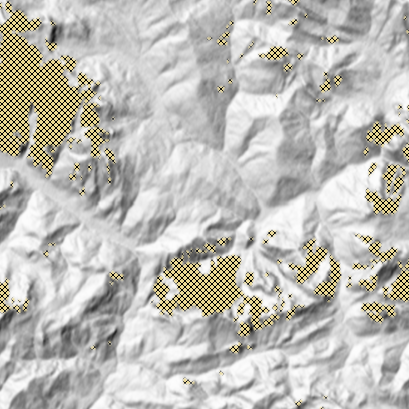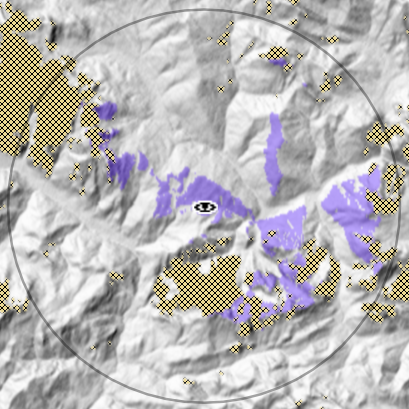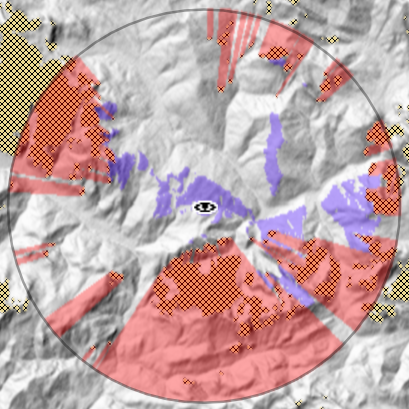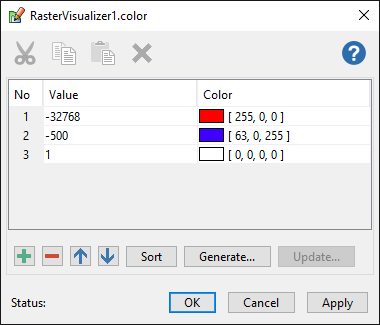LineOfSightOperator.UndefinedElevationInterpretation Property
Gets or sets the interpretation of the undefined elevation.
Syntax
public UndefinedElevationInterpretation UndefinedElevationInterpretation { get; set; }Property Value
Default: Differs depending on type. See the table below.
A value that determines how the undefined elevation is interpreted.
Default values
| Class | Default value |
|---|---|
| AirspaceCoverageOperator | NegativeElevation |
| LineOfSightOperator | NegativeElevation |
| TargetLineOfSightOperator | ZeroElevation |
Remarks
This property is implemented only for the LineOfSightOperator type. For the derived type TargetLineOfSightOperator, only the default value can be used, so the property is hidden in Carmenta Studio, and any attempt to set it to a non-default value via the API will throw a "not implemented" exception.
For LineOfSightOperator, there are three possibilities. (We use the Carmenta Studio names here; for the API-specific syntax, see UndefinedElevationInterpretation.)
NegativeElevation An undefined elevation is interpreted as an elevation lower than any possible elevation on Earth, namely −500 m.
ZeroElevation An undefined elevation is interpreted as the zero elevation.
UnknownElevation An undefined elevation is interpreted as truly unknown, and will cast a shadow of uncertainty. For the LineOfSightOperator OutputMinVisibilityHeights raster, uncertainty is represented by the special value −32 768 that will be put in the cell values along the remainder of the line of sight from the observer. For the AirspaceCoverageOperator and all other output types, using UnknownElevation will result in the shadow of uncertainty to be considered non-visible. And if a CustomPropagation is used, the undefined elevations will be represented by the lowest finite Double (approximately −1.7976931348623157e308) in the terrain profiles that are sent to the custom Propagate method, which can handle them in whatever way the custom code developer decides.
The following remarks only applies to the LineOfSightOperator OutputMinVisibilityHeights raster.
When using UnknownElevation, it is your responsibility to let your RasterVisualizer display a special color for −32 768 that signifies uncertainty. The first "certain" color would usually be for the number 0, but if the operator computes visibility heights above sea level, you should note that negative visibility heights can occur, so you first "certain" color should be for something like −500, lower than the Dead Sea.
The above text refers to elevation rasters coming from ElevationInput. For the optional tree height rasters from TreeHeightInput, the meaning is similar, except that NegativeElevation and ZeroElevation have the same effect, namely that the undefined tree height is interpreted as zero. Note that if the chosen value is UnknownElevation, then an undefined elevation or an undefined tree height will cause the sum to behave as an unknown value and throw an uncertainty shadow.
Here is an example of elevation data with some undefined areas:
 |
With the default setting, a viewshed can appear like this:
 |
If we instead choose UnknownElevation, the viewshed can appear like this:
 |
In both cases, the color table for the viewshed looked like this:
 |
Example
// Set UndefinedElevationInterpretation to UnknownElevation.
// This will cause that undefined elevation is interpreted as truly unknown,
// and will cast a shadow of uncertainty.
// In the output raster, uncertainty is represented by the special value -32768
// that will be put in the cell values along the remainder of the line of sight from the observer.
public static void SetUndefinedElevationInterpretationToUnknownElevation(
LineOfSightOperator lineOfSightOperator)
{
// This property is a member of a type that might be referred to by a View
// or a GlobeView, either directly or indirectly through other objects, which means
// that you must use the Guard class to take the global configuration lock when it
// is modified to synchronize access with any running Carmenta Engine threads.
using (Guard guard = new Guard())
{
// Set UndefinedElevationInterpretation to UnknownElevation.
lineOfSightOperator.UndefinedElevationInterpretation =
UndefinedElevationInterpretation.UnknownElevation;
}
}
Platforms
Windows, Linux, Android